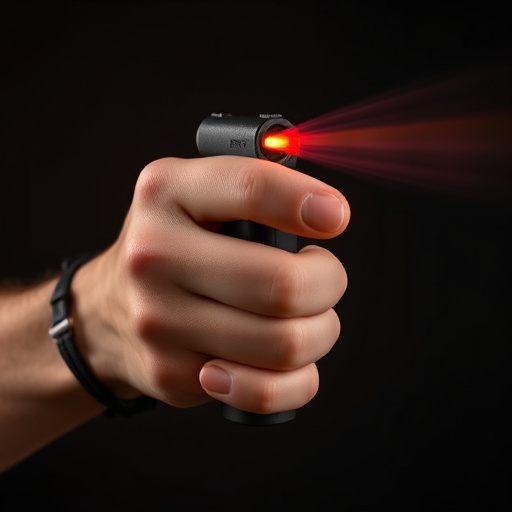Capsaicin, the active compound in chili peppers, offers anti-inflammatory benefits and enhances pepper spray's effectiveness as a non-lethal crowd control tool. By stabilizers and strategic packaging, the shelf life of pepper spray can be significantly extended (1-3 years), ensuring its potency and availability for law enforcement. Ideal storage conditions include controlled room temperature, dryness, protection from sunlight, and proper sealing to prevent moisture ingress, crucial for maintaining capsaicin's effectiveness.
“Discover the power of nature’s defense against inflammation and chaos with our exploration of capsaicin-based crowd control sprays. This innovative tool, often known as pepper spray, has become an essential element in public safety. We’ll delve into the science behind capsaicin’s anti-inflammatory properties and its role in dispersing crowds effectively. Understanding the factors influencing pepper spray shelf life is crucial for optimal usage. Learn practical strategies to extend your spray’s lifespan, ensuring its readiness when needed most.”
- Understanding Capsaicin and Its Anti-Inflammatory Properties
- The Role of Pepper Spray in Crowd Control
- Factors Affecting Pepper Spray Shelf Life
- Strategies to Extend the Lifespan of Your Pepper Spray
Understanding Capsaicin and Its Anti-Inflammatory Properties
Capsaicin, the active compound found in chili peppers, has gained significant attention for its potential beyond culinary uses. Its remarkable anti-inflammatory properties have been extensively studied, offering a unique approach to crowd control and pain management. This natural substance is not only effective but also provides an alternative to traditional chemical agents, making it a game-changer in certain applications.
The mechanism behind capsaicin’s efficacy lies in its ability to interact with the body’s vanilloid receptors, particularly TRPV1, which play a crucial role in sensing pain and inflammation. By binding to these receptors, capsaicin can reduce the transmission of pain signals, making it a valuable tool for non-lethal crowd control measures. Moreover, research suggests that capsaicin’s anti-inflammatory effects can extend its shelf life as a pepper spray, offering longer durability without compromising safety or effectiveness.
The Role of Pepper Spray in Crowd Control
Pepper spray, a crowd control agent derived from capsaicin, has become an integral part of law enforcement and security protocols worldwide. Its primary function is to disrupt and disperse large gatherings or aggressive individuals quickly and non-lethally. The active ingredient, capsaicin, triggers a burning sensation in the eyes, nose, and throat, temporarily incapacitating the target and providing time for order to be restored.
One lesser-known aspect of pepper spray is its potential for extended shelf life through various means. Manufacturers often incorporate stabilizers and packaging designs that slow down degradation, ensuring the spray remains effective for longer periods. This not only optimizes resource utilization but also enhances public safety by guaranteeing the availability of this crucial crowd control tool when needed most.
Factors Affecting Pepper Spray Shelf Life
The shelf life of pepper spray is influenced by several factors, which can significantly impact its effectiveness and potency over time. One of the primary considerations is pepper spray shelf life extension. Factors such as storage conditions play a crucial role in maintaining the spray’s integrity. Extreme temperatures, whether hot or cold, can degrade the active ingredient, capsaicin, leading to reduced efficacy. Ideal storage should be at controlled room temperature, away from direct sunlight, and in a dry environment.
Additionally, exposure to moisture can compromise the spray’s quality. High humidity levels may cause the pepper spray to become less potent as the capsaicin molecules interact with water, potentially reducing their irritant properties. Proper packaging, including airtight containers and protective coatings, helps prevent moisture ingress, thereby prolonging the shelf life of pepper spray. Regular maintenance checks and adherence to storage guidelines ensure that the spray remains effective when needed, offering optimal crowd control capabilities.
Strategies to Extend the Lifespan of Your Pepper Spray
Extending the lifespan of your pepper spray is crucial for effective crowd control and ensuring its availability when needed. One key strategy is proper storage. Keep the spray in a cool, dry place away from direct sunlight. Extreme temperatures can degrade the active ingredient, capsaicin, reducing its potency over time. A temperature-controlled environment, such as a secured locker or safe, is ideal to preserve the spray’s integrity.
Additionally, maintaining the spray’s original packaging and ensuring it remains sealed helps prevent contamination and moisture absorption. Pepper spray has a limited shelf life, typically ranging from 1 to 3 years, depending on the brand and storage conditions. Regularly checking the expiration date and replacing the spray before its effectiveness fades ensures you’re prepared for any inflammatory crowd control situations.
Capsaicin-based inflammatory crowd control sprays have proven to be valuable tools for law enforcement and security personnel. Understanding capsaicin’s anti-inflammatory properties, its role in crowd control, and the factors affecting pepper spray shelf life are essential steps towards effective deployment. By implementing strategies to extend the lifespan of pepper spray, such as proper storage and maintenance, users can ensure optimal performance when it matters most, enhancing safety and security measures. These practices contribute to the overall efficiency and reliability of these crowd control solutions in various scenarios.
